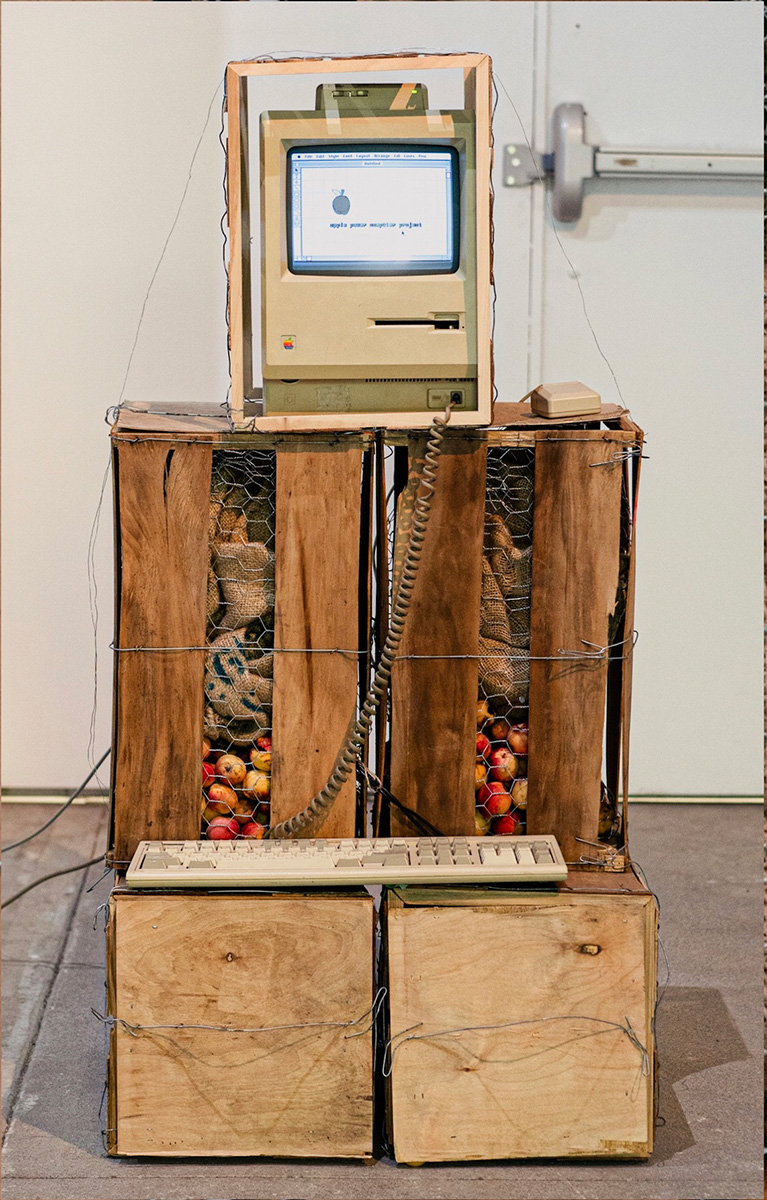This gleaned Macintosh Plus computer (circa 1987) is powered by a huge apple battery made from crab apples (similar to the “potato clock” experiment conducted in elementary school science classes ). The crab apples and computer are housed in a cabinet made of repurposed hog-feed crates. This project is part of a larger body of work I made that explores a fictionalized near-present where the ethos of gleaning is brought into web/PC culture. It was exhibited at Interacess in IA Currents 2022 in Toronto, Ontario.
All images and text provided by Sarah Holloway
How can we borrow from craft and agricultural practices, to create new computational futures by reactivating and reimagining the principles behind our computational tools?
DESIGN PROCESS
Over the past few years, I have grown twin flame interests in computation and ecology, leading to a convergence of these interests in the field of Permacomputing. A term coined by Ville-Matias “Viznut” Heikkilä, Permacomputing uses the ideas of permaculture to look at how we build and use our computational tools and their connection to larger, local, and global systems. I have had a special liking for potato clocks and batteries because I think there is something so simply magical about them. They bridge the weird gap between science, food and technology. So by chance when I found a Macintosh Plus computer left unused, I decided to adopt it into this project.
Gleaning unwanted or unusable things is a huge part of my practice, so I set about the challenge of finding lots of green potatoes (ones that can’t be eaten) but when there was a really small crop of potatoes in Rhode Island (where I was then living) I pivoted to what was in season at the time and in abundance: apples. All the apples collected were apples that had fallen and by food regulatory standards couldn’t be sold for eating anymore. The cabinet the project is housed in is modular and easy to store so when people ask me to break it out I will–but only in the fall when I can get my hands on more leftover produce.
The second installment of the project was in Toronto and from where I was staying it was easier to jump on Kijiji (a Canadian version of Craigslist) and find someone who had a lot of crab apples. I found someone an hour away and drove to pick up hundreds of small little crab apples that would have been put out as yard waste. The ethos of the project is part “are you using that?” and part up to fate in hopes of reconsidering our relationship to our daily technologies.
It took a lot of apples to run the computer and it didn’t last for long but the point still was there, that all our systems are connected and our food and ecological systems are either directly or indirectly tied to our computers and digital technologies. Data centers take up space like mono crops and they take insane amounts of energy. The project is meant to be a fun way of wondering how our food and tech systems make strange bedfellows. A few weeks ago I was talking to a friend who told me about a farm her friend manages. It is owned by a tech company based in Vancouver, Canada. They have a farm that tech workers are allowed to go to for “rejuvenation”. (Think therapy horses but like pulling carrots).
The world is a weird place where technology and industry are flowing into all other sectors.
ABOUT THE PRACTICE
Sarah Holloway is curious about how older ways of knowing at the heart of traditional craft disciplines can be brought into our digital futures and the furniture accompanying them. In her practice, she melds the aesthetics of PC culture with traditional craft aesthetics. In her work you can commonly see high-tech fabrication like CNC’ing mixed with hand-hewn wood and mixing of materials like ionized aluminum and hardwood.





